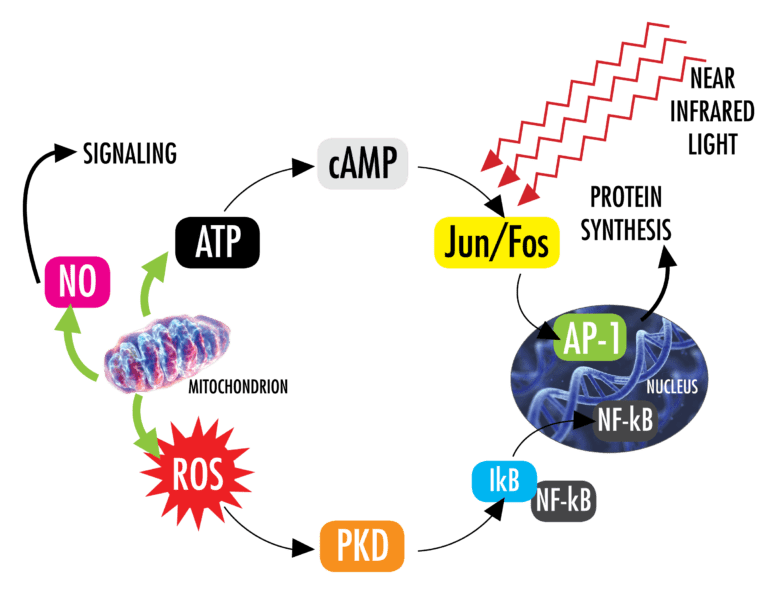The 45-Second Trick For Photobiomodulation
Wiki Article
The Definitive Guide for Photobiomodulation
Table of ContentsSome Of PhotobiomodulationThe Ultimate Guide To PhotobiomodulationRumored Buzz on PhotobiomodulationPhotobiomodulation for Beginners
Laser treatment is a clinical treatment that makes use of focused light to stimulate a process called. Throughout PBM, photons enter the tissue and connect with the cytochrome c complex within mitochondria. This interaction causes a biological waterfall of events that brings about a rise in cellular metabolism, which can along with increase the healing procedure.There is agreement that the application of a restorative dosage of light to damaged or inefficient tissue brings about a cellular feedback moderated by mitochondrial systems. Photobiomodulation. Researches have revealed that these modifications can affect discomfort and swelling, along with, tissue repair
Adjustments in ATP, responsive oxygen varieties and nitric oxide adhere to light absorption by Cc, O. These impacts are redox state and dosage reliant.

An Unbiased View of Photobiomodulation
PBM tools have been removed for marketing by FDA with the Premarket Notification/510( k) procedure as adjunctive gadgets for the short-term alleviation of pain. These clearances were based on the presentation of professional information to support such claims (Photobiomodulation). In this therapy, a light is put near or touching the skin, allowing the light power (photons) to penetrate tissue where it connects with chromophores situated in cells resulting in photophysical and photochemical modifications that cause alterations at the molecular, cellular and tissue degrees of the bodyInterestingly, current study suggests that light can boost efficiency in typical cells and cells. The potential applications of PBMT are many and are being checked out experimentally at the basic science, pre-clinical and scientific level. The present professional usages are for the alleviation of discomfort and swelling and the treatment of sports injuries.

The therapy specifications and number of sessions required for PBMT are dependent upon place and cause. PBMT normally requires more than one treatment for optimal discomfort alleviation. It may take numerous treatments for the results to end up being obvious. records that it can take anywhere from 8 to 30 sessions for a treatment to be completely reliable, and some clients locate it necessary to undertake therapy two to four times per week.
The Buzz on Photobiomodulation
Therapy criteria for PBMT were originally developed making use of cells artificial insemination and in tiny pet designs. These treatment specifications typically had a reduced irradiance and fluence and functioned well for cutaneous applications. When medical professionals started to use PBMT to deal with frameworks that were situated deeper in the body, they utilized these criteria with adverse results.
We now recognize that these adverse studies were due to incorrect device and therapy specifications for transcutaneous therapy of much deeper structures. Recent breakthroughs in laser therapy gadgets and more research study into the proper dosages have significantly enhanced the results of PBMT. For dealing with deep tissues, the wavelength of light used identifies the deepness of infiltration right into a cells.
It is crucial that a clinician makes use of the suitable wavelength of light and specifications to treat a condition. One wavelength and one collection of therapy parameters will certainly not be effective for all conditions. Negative side results have actually not been reported from the usage of PBMT.
Excitement About Photobiomodulation
In the initial experiment, Dr. Endre Mester, made use of cut rats and observing how the laser impacted their see this page capacity to grow hair contrasted to the team that was not receiving LLLT. He located that the group of computer mice getting LLLT were able to expand their hair back faster than the team of computer mice that really did not get LLLT (Hoon C, et al; 2012).This therapy is termed by doing this to set apart the distinction in between the lasers some careers use to cut (eg. in surgical procedures, or oral treatments). Low-level light therapy is pain-free, non-invasive treatment. It is made use of to decrease inflammation, swelling, and chronic joint conditions, decrease pain and speed up injury healing of nerves and cells (Hoon C, et alia; 2012).
LLLT has a biphasic action, meaning that reduced dosages are usually attended be more advantageous than higher doses. That being stated, dosages greater or less than the ideal dose doesn't affect (Hoon C, et alia; 2012). Consequently, it can be tough to have studies on LLLT with numerous specifications.
Some firms combined both (LED and laser) to offer an extra well-rounded treatment since lasers can pass through much deeper than LED and infrared light (Norman Doidge, The Brain's Means of Recovery, 2015). During treatment, the location that is being treated is exposed to LED light from a Bio, Flex Laser, which goes to 660 nm wavelength, followed by infrared light at 830-840 nm wavelength.
Report this wiki page